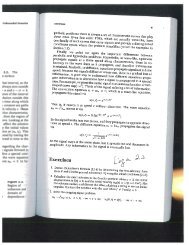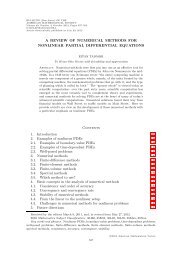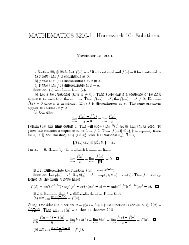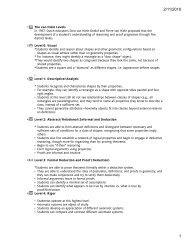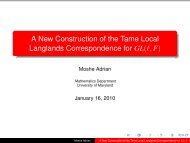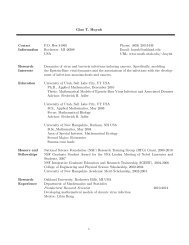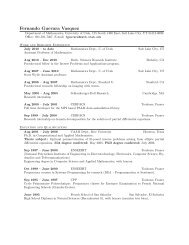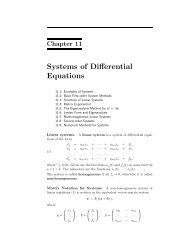MATH 6210: SOLUTIONS TO PROBLEM SET #3
MATH 6210: SOLUTIONS TO PROBLEM SET #3
MATH 6210: SOLUTIONS TO PROBLEM SET #3
Create successful ePaper yourself
Turn your PDF publications into a flip-book with our unique Google optimized e-Paper software.
4<br />
Rudin, Chapter 5, Problem #7. Let X be a finite set with the counting<br />
measure. So V := L 1 (X) ≃ C n . Let U be any nonzero subspace of V of dimension<br />
m < n. A linear functional Λ on U is given by a 1-by-m matrix. It’s norm is the<br />
maximum of the absolute value of its entries. We can extend Λ to V by adding n−m<br />
new entries. If they all have absolute value less than the norm of Λ, the extension<br />
is norm-preserving. So there are infinitely many norm-preserving extensions of Λ<br />
from U to V . ˜<br />
Rudin, Chapter 5, Problem #8. For (a), note that is follows from the definitions<br />
that X ∗ is a normed vector space. The more subtle fact is that it is complete.<br />
So let Λ1, Λ2, . . . be a Cauchy sequence in X ∗ . Then since each difference Λi − Λj<br />
is bounded, the sequence Λ1(x), Λ2(x), . . . is a Cauchy sequence in C for each fixed<br />
x ∈ X. So the pointwise limit Λ(x) := limn→∞ Λi(x) is well-defined. A quick check<br />
shows Λ is linear. To see it is bounded, note first that since {Λi} is Cauchy, {||Λi}<br />
is bounded by, say, N. Fix x ∈ X with ||x|| = 1. Then<br />
|Λ(x)| = lim<br />
n→∞ |Λi(x)| ≤ N||x|| = N.<br />
So, indeed, Λ is bounded.<br />
The last thing to check is that Λi → Λ in the norm on X ∗ . I leave this to you.<br />
For (b), define Φ from X ∗ to C by evaluation at some fixed x in X. This is<br />
clearly linear. To check that it is bounded, compute for ||Λ|| = 1,<br />
So, indeed, Φ is bounded.<br />
|Φ(Λ)| = |Λ(x)| ≤ ||Λ|| · ||x|| = ||x||.<br />
Finally, for (c), let {xn} be a sequence in X such that {Λ(xn)} is bounded<br />
for all Λ ∈ X ∗ . Let Φn be the map from X ∗ to C defined by evaluating at xn.<br />
So {Λ(xn)} bounded for all Λ literally means {Φn(Λ)} is bounded for all Λ. By<br />
Banach-Steinhaus, {||Φn||} = {||xn||} is bounded.<br />
˜<br />
Rudin, Chapter 5, Problem #20. For (a), a short argument shows that the set<br />
of points x for which {fn(x)} is a Gδ set. If it consisted of the rationals, then the<br />
rationals would be a dense Gδ in R, something prohibited by the Baire Category<br />
Theorem.<br />
For (c) (and hence (b)), enumerate the rationals in (0, 1) as r1, r2, .... and let<br />
fn be the piecewise linear function through (0, 0), (r1, 1), . . . , (rn, n), (1, 0). This<br />
is a sequence of functions such that the set of x with fn(x) → ∞ is exactly the<br />
irrationals. ˜<br />
Rudin, Chapter 6, Problem #1. Yes, we need only work with finite partitions.<br />
Let {Fα}α∈A be any (infinite) partition of E. It suffices to find a finite subset<br />
S ⊂ A such that <br />
α∈S |µ(Fα)| is within ǫ of <br />
α∈A |µ(Fα)|. Since the latter sum<br />
is finite and absolutely convergent, there is a finite partial sum which is within ǫ of<br />
the total sum. This partial sum defines S, as required. ˜




